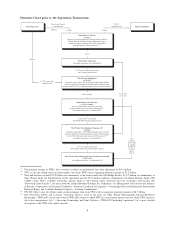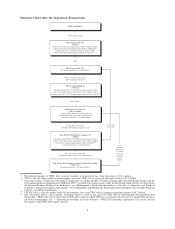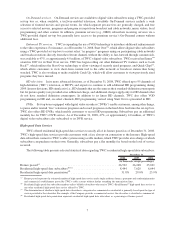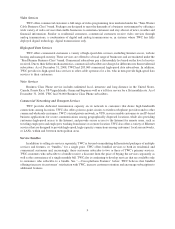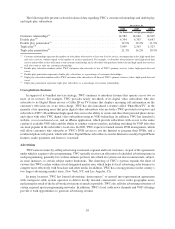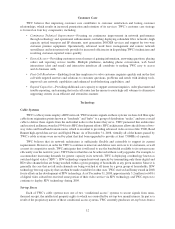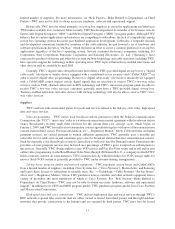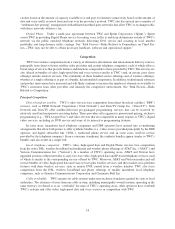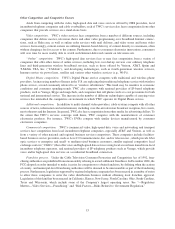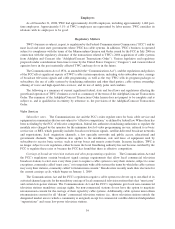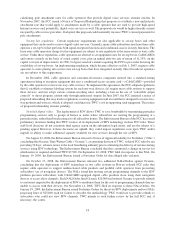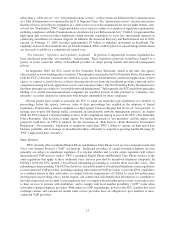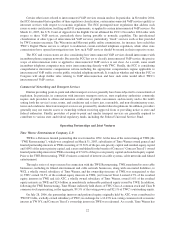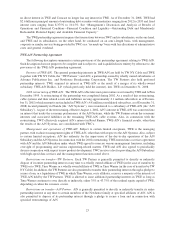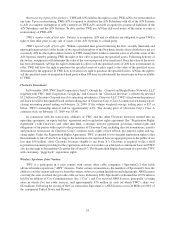Time Warner Cable 2008 Annual Report Download - page 24
Download and view the complete annual report
Please find page 24 of the 2008 Time Warner Cable annual report below. You can navigate through the pages in the report by either clicking on the pages listed below, or by using the keyword search tool below to find specific information within the annual report.circuits based on the amount of capacity available to it and pays for Internet connectivity based on the amount of
data and voice traffic received from and sent over the provider’s network. TWC also has entered into a number of
“settlement-free peering” arrangements with affiliated and third-party networks that allow TWC to exchange traffic
with those networks without a fee.
Digital Phone. Under a multi-year agreement between TWC and Sprint Corporation (“Sprint”), Sprint
assists TWC in providing Digital Phone service by routing voice traffic to and from destinations outside of TWC’s
network via the public switched telephone network, delivering E911 service and assisting in local number
portability and long-distance traffic carriage. See “Risk Factors—Risks Related to Dependence on Third Par-
ties—TWC may not be able to obtain necessary hardware, software and operational support.”
Competition
TWC faces intense competition from a variety of alternative information and entertainment delivery sources,
principally from direct-to-home satellite video providers and certain telephone companies, each of which offers a
broad range of services that provide features and functions comparable to those provided by TWC. The services are
also offered in bundles of video, high-speed data and voice services similar to TWC’s and, in certain cases, these
offerings include wireless services. The availability of these bundled service offerings and of wireless offerings,
whether as a single offering or as part of a bundle, has intensified competition. In addition, technological advances
and product innovations have increased and will likely continue to increase the number of alternatives available to
TWC’s customers from other providers and intensify the competitive environment. See “Risk Factors—Risks
Related to Competition.”
Principal Competitors
Direct broadcast satellite. TWC’s video services face competition from direct broadcast satellite (“DBS”)
services, such as DISH Network Corporation (“Dish Network”) and DirecTV Group Inc. (“DirecTV”). Dish
Network and DirecTV offer satellite-delivered pre-packaged programming services that can be received by
relatively small and inexpensive receiving dishes. These providers offer aggressive promotional pricing, exclusive
programming (e.g., “NFL League Pass”) and video services that are comparable in many respects to TWC’s digital
video services, including its DVR service and some of its interactive programming features.
In some areas, incumbent local telephone companies and DBS operators have entered into co-marketing
arrangements that allow both parties to offer synthetic bundles (i.e., video service provided principally by the DBS
operator, and digital subscriber line (“DSL”), traditional phone service and, in some cases, wireless service
provided by the telephone company). From a consumer standpoint, the synthetic bundles appear similar to TWC’s
bundles and also result in a single bill.
Local telephone companies. TWC’s video, high-speed data and Digital Phone services face competition
from the video, DSL, wireless broadband and traditional and wireless phone offerings of AT&T Inc. (“AT&T”) and
Verizon Communications Inc. (“Verizon”). In a number of TWC’s operating areas, AT&T and Verizon have
upgraded portions of their networks to carry two-way video, high-speed data and IP-based telephony services, each
of which is similar to the corresponding service offered by TWC. Moreover, AT&T and Verizon market and sell
service bundles of video, high-speed data and voice services plus wireless services, and they market cross-platform
features with their wireless services, such as remote DVR control from a wireless handset. TWC also faces
competition from the DSL, wireless broadband and phone offerings of smaller incumbent local telephone
companies, such as Frontier Communications Corporation and Cincinnati Bell, Inc.
Cable overbuilds. TWC operates its cable systems under non-exclusive franchises granted by state or local
authorities. The existence of more than one cable system, including municipality-owned systems, operating in the
same territory is referred to as an “overbuild.” In some of TWC’s operating areas, other operators have overbuilt
TWC’s systems and offer video, high-speed data and voice services in competition with TWC.
14


